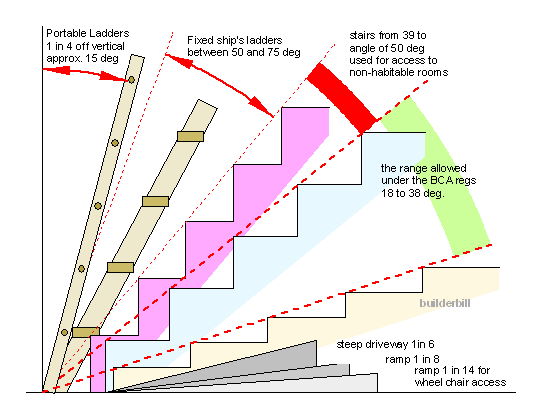 |
|||||
Graphical Construction Glossary >> stairs. >> >> Stair Angles
The sketch above provides a depiction of a range of methods that can be used to travel by foot from one level to another. The missing one is a fixed vertical ladder that is normally caged or with safety harness fitting for specialised access to parts of a building by maintenance workers etc. There is a detailed page on ladders here. Ships ladders or companionway ladders are usually fixed. The next rough classification is the steep stair type which is between 39 and 50 degrees. These are not to be used as main stairs but they are permitted in many regulations to be used for infrequent access to non-habitable rooms. The section that has a green arc is the normally accepted range for ordinary stairs. This is the accepted range in Australia under the building code of Australia as of 2010 but as I often say. Check your own particular regulations.
This stair is shown here as an example of a stair that is above the critical angle. That is it is too steep for a normal stair. If you didn't find exactly what you are looking for try this search tool that will search the site and the web. "What can be added to the happiness of a man who is in health, out of debt, and has a clear conscience? "When we build, let us think that we build for ever."John Ruskin 1819-1900 |
Hire Equipment  Furniture Fittings - Architectural Hardware - Electronic Locking Systems - Technical Hardware BuilderBill sponsorship Glossary Pages.Roof Glossary and Roofing Formwork Glossary and other tempory work. Hand Tools Glossary Power Tools Glossary Asbestos Glossary Woodwork Glossary Stair Glossary Concrete Glossary Masonry Glossary doors Glossary BuilderBill Books Building Maths  Stair Design  Asbestos Book |
||||
|
|
|||||
|
Please Note! The information on this site is offered as a guide only! When we are talking about areas where building regulations or safety regulations could exist,the information here could be wrong for your area. It could be out of date! Regulations breed faster than rabbits! You must check your own local conditions. Copyright © Bill Bradley 2007-2012. All rights reserved. |
|||||

